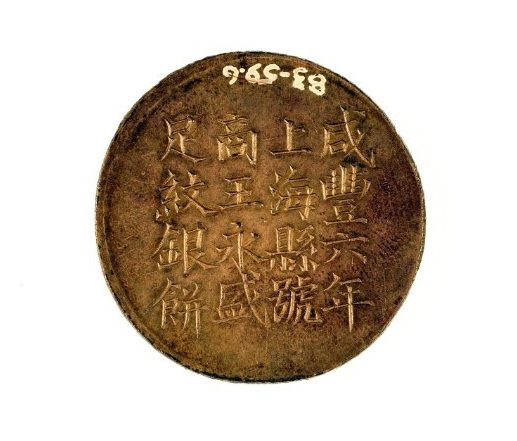In this blogpost, Student Research Assistant, Sisi Li, examines two Chinese coins from the University of Regina Collection at the MacKenzie Art Gallery. Both coins were bequeathed to the University on Norman MacKenzie’s death in 1936. Read part II here.
Norman MacKenzie owned a small collection of Chinese coins in the early twentieth century. These coins come from different eras and regions in China. In this article, we will explore the historical stories of two of these coins.

This is a Shanghai silver coin from 1856 (Fig. 1). The text reads: “Xian Feng Liu Nian, Shang Hai Xian Hao, Shang Wang Yong Sheng, Zu Wen Yin Bing (咸丰六年,上海县号,商王永盛,足纹银饼).” The general meaning of the text describes how this coin was produced in Shanghai in the 6th year of Xianfeng, with the manufacturer listed as Wang Yongsheng, and that it is worth one tael. A tael was unit of currency formerly used in China, equivalent in value to the weight of standard silver. Most taels were equivalent to 1.3 ounces of silver.
In the sixth year of Emperor Xianfeng’s reign (1856), Shanghai issued a set of silver coins in the name of three shipping companies (Wang Yongsheng 王永盛, Yu Sensheng 郁森盛, and Jing Zhengji 经正记) (Fig. 2), which were produced separately by each company. There are no graphics on the coin surface, only text, and the year, place, manufacturer, name of the supervisor and craftsman, and color and weight are marked. There are four lines of text on the front and back, with four characters on each line (for a total of thirty-two characters). This silver coin in Norman MacKenzie’s collection is one of the six silver coin styles, made by the most powerful Wang Yongsheng company. Shen Baohe 沈宝禾 of the Qing Dynasty recorded in the Journal of Ren Mo Shu Tui Zhi Zhai 忍默恕退之斋日记稿, “In the fifth year of Xianfeng (1855), there were 24 famous ship merchants in Shanghai, and Wang Yongsheng and Yu Sensheng ranked first and second respectively, both of which were famous ship merchants for transporting sand in Shanghai.”(“咸丰五年(1855年),上海有名船商二十四人,王永胜、于森生分别排名第一和第二,都是上海著名的运沙船商”).

(source: https://m.thepaper.cn/rss_newsDetail_8417513?from=)
There were two reasons Shanghai issued the Shanghai Silver Coin in 1856. Firstly, there was a shortage of currency in circulation, and secondly, the coin production functioned as a boycott of Mexican silver coins. Before China enacted the National Currency Regulations law in 1914, Mexican silver coins circulated in large quantities in China. The monetary attribute of silver was determined by the international market, and was therefore not restricted by national boundaries. Additionally, the circulation of banknotes relied on the coercive force of the government and the credit of the issuing bank. Beyond the control of the government and the National Bank, paper money was just paper, but gold and silver remained inherently valuable. In addition, China lacked silver mines, but had a huge demand for silver, so it needed a large amount of imported silver to meet domestic circulation needs. Mexico, on the other hand, has long been the world’s largest silver producer.
According to a report in the English newspaper Beihua Jiebao in Shanghai on November 29, 1856, “Shanghai also promoted Mexican silver coins and Shanghai silver coins… The Shanghai government successfully produced a batch of silver coins. Here are the two very delicate sides of this silver coin. The silver coins have lace and weigh one tael. We believe that the people will accept these silver coins, but these silver coins will not have any impact on commerce, because only 3,000 pieces can be produced every month.” The Xianfeng Silver Coin is rarely handed down, and all of them are marked with the words “Xianfeng six years”. The issuance time of these coins was only half a year, indicating production was not smooth. Once they were issued, fakes began to circulate in the market, and soon the Shanghai government announced that they would stop issuing them. Coupled with low output and high cost, it was difficult for the Shanghai coins to compete with Mexican coins in circulation at that time.
Bibliography
Weidong Guo, “Chinese Coins and Mexican Silver Coins: Circulation of Foreign Currencies in China “本洋”与“鹰洋”:近代流通中国主要外币的替换,” FuJian LunTan (Social Science Edition), no.7 (2019): 101-112.
Shen Baohe沈宝禾, “Journal of Ren Mo Shu Tui Zhi Zhai忍默恕退之斋日记稿,” in Collection of Manuscripts and Notebooks and Diaries in Shanghai Library (86 volumes in total) 上海图书馆藏稿钞本日记丛刊 全八十六册 (National Library of China Publishing House, 2017), Vol 23.